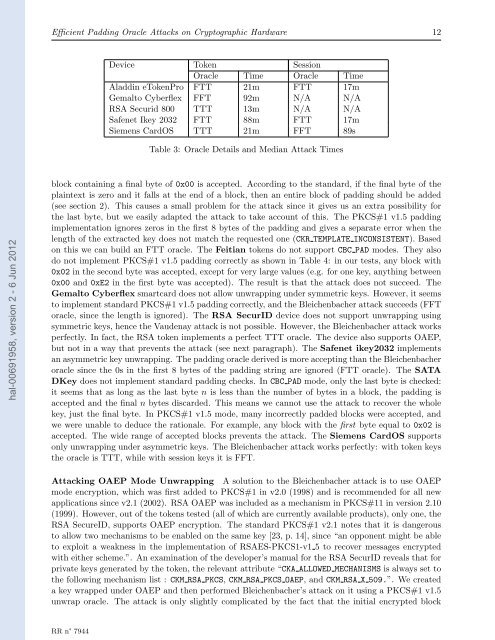RR-7944
RR-7944
RR-7944
You also want an ePaper? Increase the reach of your titles
YUMPU automatically turns print PDFs into web optimized ePapers that Google loves.
hal-00691958, version 2 - 6 Jun 2012<br />
Efficient Padding Oracle Attacks on Cryptographic Hardware 12<br />
Device Token Session<br />
Oracle Time Oracle Time<br />
Aladdin eTokenPro FTT 21m FTT 17m<br />
Gemalto Cyberflex FFT 92m N/A N/A<br />
RSA Securid 800 TTT 13m N/A N/A<br />
Safenet Ikey 2032 FTT 88m FTT 17m<br />
Siemens CardOS TTT 21m FFT 89s<br />
Table 3: Oracle Details and Median Attack Times<br />
block containing a final byte of 0x00 is accepted. According to the standard, if the final byte of the<br />
plaintext is zero and it falls at the end of a block, then an entire block of padding should be added<br />
(see section 2). This causes a small problem for the attack since it gives us an extra possibility for<br />
the last byte, but we easily adapted the attack to take account of this. The PKCS#1 v1.5 padding<br />
implementation ignores zeros in the first 8 bytes of the padding and gives a separate error when the<br />
length of the extracted key does not match the requested one (CKR TEMPLATE INCONSISTENT). Based<br />
on this we can build an FTT oracle. The Feitian tokens do not support CBC PAD modes. They also<br />
do not implement PKCS#1 v1.5 padding correctly as shown in Table 4: in our tests, any block with<br />
0x02 in the second byte was accepted, except for very large values (e.g. for one key, anything between<br />
0x00 and 0xE2 in the first byte was accepted). The result is that the attack does not succeed. The<br />
Gemalto Cyberflex smartcard does not allow unwrapping under symmetric keys. However, it seems<br />
to implement standard PKCS#1 v1.5 padding correctly, and the Bleichenbacher attack succeeds (FFT<br />
oracle, since the length is ignored). The RSA SecurID device does not support unwrapping using<br />
symmetric keys, hence the Vaudenay attack is not possible. However, the Bleichenbacher attack works<br />
perfectly. In fact, the RSA token implements a perfect TTT oracle. The device also supports OAEP,<br />
but not in a way that prevents the attack (see next paragraph). The Safenet ikey2032 implements<br />
an asymmetric key unwrapping. The padding oracle derived is more accepting than the Bleichenbacher<br />
oracle since the 0s in the first 8 bytes of the padding string are ignored (FTT oracle). The SATA<br />
DKey does not implement standard padding checks. In CBC PAD mode, only the last byte is checked:<br />
it seems that as long as the last byte n is less than the number of bytes in a block, the padding is<br />
accepted and the final n bytes discarded. This means we cannot use the attack to recover the whole<br />
key, just the final byte. In PKCS#1 v1.5 mode, many incorrectly padded blocks were accepted, and<br />
we were unable to deduce the rationale. For example, any block with the first byte equal to 0x02 is<br />
accepted. The wide range of accepted blocks prevents the attack. The Siemens CardOS supports<br />
only unwrapping under asymmetric keys. The Bleichenbacher attack works perfectly: with token keys<br />
the oracle is TTT, while with session keys it is FFT.<br />
Attacking OAEP Mode Unwrapping A solution to the Bleichenbacher attack is to use OAEP<br />
mode encryption, which was first added to PKCS#1 in v2.0 (1998) and is recommended for all new<br />
applications since v2.1 (2002). RSA OAEP was included as a mechanism in PKCS#11 in version 2.10<br />
(1999). However, out of the tokens tested (all of which are currently available products), only one, the<br />
RSA SecureID, supports OAEP encryption. The standard PKCS#1 v2.1 notes that it is dangerous<br />
to allow two mechanisms to be enabled on the same key [23, p. 14], since “an opponent might be able<br />
to exploit a weakness in the implementation of RSAES-PKCS1-v1 5 to recover messages encrypted<br />
with either scheme.”. An examination of the developer’s manual for the RSA SecurID reveals that for<br />
private keys generated by the token, the relevant attribute “CKA ALLOWED MECHANISMS is always set to<br />
the following mechanism list : CKM RSA PKCS, CKM RSA PKCS OAEP, and CKM RSA X 509.”. We created<br />
a key wrapped under OAEP and then performed Bleichenbacher’s attack on it using a PKCS#1 v1.5<br />
unwrap oracle. The attack is only slightly complicated by the fact that the initial encrypted block<br />
<strong>RR</strong> n° <strong>7944</strong>


